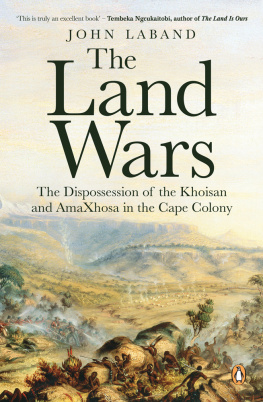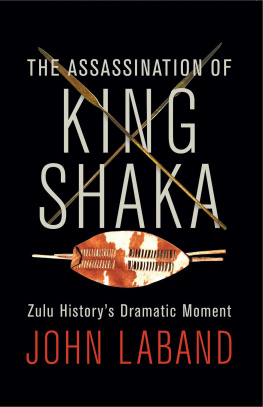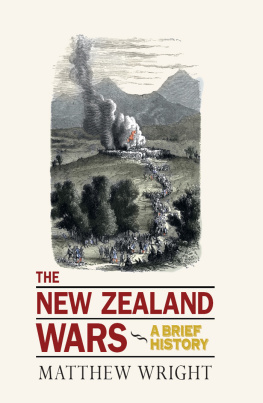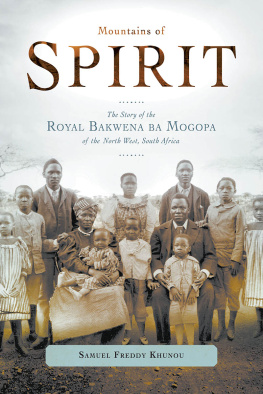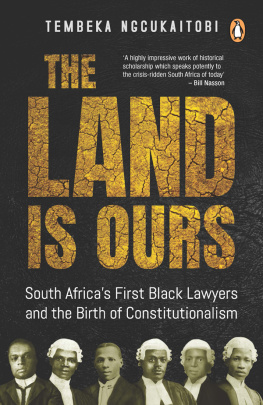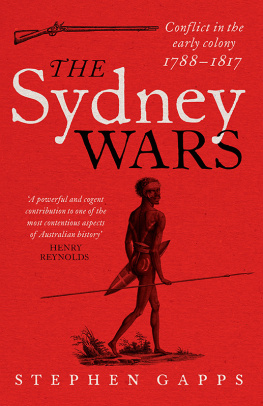
Praise for The Land Wars
This book is an immensely readable and valuable account of a brutal process the conquest and dispossession of the Khoisan and amaXhosa on the frontiers of colonial expansion during the eighteenth and nineteenth centuries. John Laband has produced a work of elegant synthesis, fast moving and sharply detailed, incisive in judgement and infused with a deep sympathy for the tragic dimensions of the events described. Though the book displays Labands characteristically keen appreciation of military matters, this is far more than a traditional trumpet and drum military history. Its pages are populated by some of the most colourful characters in South African history, brought alive by vivid thumbnail sketches. But the narrative of their heroic or criminal deeds helps to illuminate the involvement of countless nameless South Africans who endured or perished in these violent times. Labands book will help his readers to a better understanding of this complicated and decisive period. Above all it is a timely reminder of the centrality of land as a source of power, wealth and conflict in South African society.
Nigel Penn, University of Cape Town
The story of South Africa is a story of war. And the eastern frontier is emblematic of that story. While earlier wars of the Dutch against the indigenous people of todays Western Cape marked the origins of war, it was the eastern frontier which defined it as the British sought to extend their sphere of influence over the continent of Africa. That story would later be replicated across the country. The shaping of modern South Africa can only be fully understood if the story of the eastern frontier is remembered. Told from the perspective of loss of land, this book opens a new chapter in our reimagination of the past, illuminating the characters of resistance over a period of a hundred years, and making sense of todays reality. This is truly an excellent book. Tembeka Ngcukaitobi, author of The Land Is Ours
It is difficult to find words to express John Labands achievement in this book. He tells the story of complex brutality and misery with such grace and elegant prose. As in his previous work, Laband demonstrates an unrivalled depth of historical knowledge. This book puts the current debates on land reform in South Africa in their proper historical and bloody context. It is a triumphant achievement from a master historian and a master storyteller.
Bongani Ngqulunga, University of Johannesburg, author of The Man Who Founded the ANC
John Laband is a Professor Emeritus of History, Wilfrid Laurier University, Canada, and a research associate in the Department of History, Stellenbosch University. He is also a life member of Clare Hall, University of Cambridge, and a fellow of the University of KwaZulu-Natal. He specialises in the history o f the Zulu kingdom and in colonial wars in Africa. Among his recent books are The Assassination of King Shaka ( 2017 ); The Battle of Majuba Hill: The Transvaal Campaign 18801881 ( 2017 ); and The Eight Zulu Kings from Shaka to Goodwill Zwelithini ( 2018 ).
Published by Penguin Books
an imprint of Penguin Random House South Africa (Pty) Ltd
Reg. No. 1953/000441/07
The Estuaries No. 4, Oxbow Crescent, Century Avenue, Century City, 7441
PO Box 1144, Cape Town, 8000, South Africa
www.penguinrandomhouse.co.za

First published 2020
Publication Penguin Random House 2020
Text John Laband 2020
Cover image: The Hogs Back or a Great Peak of the Amatola, British Kaffraria, by Thomas Baines (182075) / Private Collection / Photo Bonhams, London, UK / Bridgeman Images
All rights reserved. No part of this publication may be reproduced, stored in a retrieval system or transmitted, in any form or by any means, electronic, mechanical, photocopying, recording or otherwise, without the prior written permission of the copyright owners.
PUBLISHER : Marlene Fryer
EDITOR : Robert Plummer
PROOFREADER : Lauren Smith
COVER DESIGNER : Ryan Africa
TYPESETTER : Monique van den Berg
INDEXER : Sanet le Roux
Set in 11 pt on 15 pt Minion
ISBN 978 1 77609 499 8 (print)
ISBN 978 1 77609 500 1 (ePub)
Contents
Abbreviations
ANC: African National Congress
CMR: Cape Mounted Riflemen
Contralesa: Congress of Traditional Leaders of South Africa
EFF: Economic Freedom Fighters
FAMP: Frontier Armed and Mounted Police
KCB: Knight Commander of the Bath
LMS: London Missionary Society
NCO: non-commissioned officer
RE: Royal Engineers
RN: Royal Navy
VOC: Vereenigde Oost-Indische Compagnie (Dutch East India Company)






Genealogical Table

Introduction
The Land Has Died
I N THE PRESENCE of members of the Sandile Traditional Council, on May and June 2005 a team from the Department of Anatomy at the University of Pretoria respectfully exhumed a grave on remote farmland between the villages of Keiskammahoek and Braunschweig in South Africas Eastern Cape province, about thirty-five kilometres north of King Williams Town. The excavation required the initial removal of a granite slab placed over the grave, on top of which stood a memorial plinth crowned by a sculptured bust of an African man. An inscription on the monument reads: In Memory of Paramount Chief Sandile, (A.A. Mgolombane) Son of Ngqika, Born in 1820 , Died and Buried on the th June 1878 . The monument had been erected in 1972 at the request of Paramount Chief Apthorpe Mxolisi Sandile, who insisted that his renowned ancestor, who had died while fighting British troops and Cape colonial forces, deserved a fitting memorial as a hero of Xhosa resistance against colonialism.
The exhumation had been prompted by the pervasive oral tradition that, before the British buried his body, Sandiles head had been cut off and that Lieutenant Frederick Carrington had carried the skull away to England as a grisly trophy. For many amaXhosa this narrative rang only too true. The barbarous and disrespectful decapitation of Sandile symbolised the many atrocities committed against their people in the colonial era, outrages that were accompanied by the dispossession of their land and the destruction of their way of life.
The investigating team found the skeletal remains in poor condition, but they were indubitably those of an African male in middle age, as Nkosi Sandile had been. He was known always to have walked with a limp, and what confirmed the skeleton as his was the abnormal left tibia (shinbone) which indicated a congenital weakness in the lower leg. Sandiles skull was still in place, conclusively laying to rest the legend of its removal. The team retrieved fragments of broken bottles on a stone cairn below the 1972 memorial, consistent with the cultural practice of placing food offerings on a grave. Cartridge cases were also uncovered, confirming the contemporary report that those who had buried Sandile fired a military salute over the grave.
Next page
